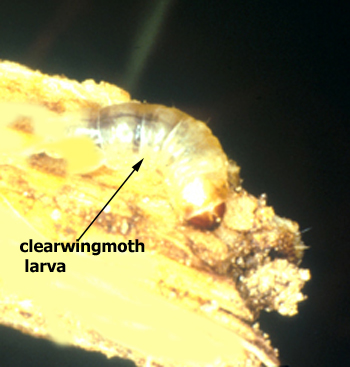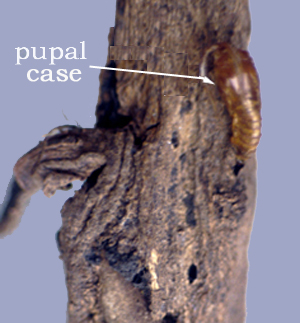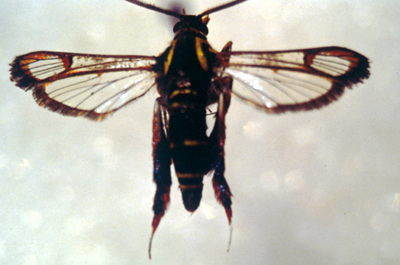|
|
Class
|
Insecta
|
|
Order
|
Lepidoptera
|
|
Family
|
Sesiidae
|
Synanthedon
spp. are found in many localities, but are seldom a serious pest.
Kenya, Tanzania, Uganda.
The larvae burrow into the vines and sometimes into the tip of
the storage roots via the vine. The vine base is characteristically swollen and
traversed with feeding galleries. With heavy infestation, the stem cracks
and breaks off easily at the base.
The eggs are yellowish, while the larvae
are whitish with transparent skin and a brown head capsule. They can grow up to
2.5 cm long. The pupae are covered by a
greyish brown pupal case. The adult moths have distinctive transparent wings
with a wingspan of about 20 mm.
Synanthedon damage is seldom serious, but can discourage
farmers who for food security reasons try to keep their sweetpotato crop in the
field for a long period.
Eggs are laid in clusters of 70-100 on the stems and leaf
stalks; hatching takes a few days. The caterpillars bore into the vines, where
they tunnel down to the vine base. Pupation occurs mostly at the vine base just
above ground level.
Synanthedon damage is often attributed to Cylas
spp. However, the swelling of the stem base is mostly more
severe and brown pupal cases can be seen protruding from the swollen vine.
Control of this pest is seldom necessary.
Cultural control
Measures
like sufficient rotation, use of clean planting material, field sanitation and timely
harvesting should be effective in reducing incidence of this pest.
Ames,
T., Smit, N.E.J.M., Braun, A.R., O’Sullivan, J.N., and Skoglund, L.G. 1996.
Sweetpotato: Major pests diseases, and nutritional disorders. International
Potato Center (CIP). Lima, Perú. 152 p.
Bradley,
J.D. 1968. Two new species of clearwing moths (Lepidoptera; Sesiidae) associated
with sweetpotato (Ipomoea batatas) in East Africa. Bull. ent. Res. 58:
47-53.
Hill,
D.S. 1983. Agricultural insect pests of the tropics and their control - 2nd ed.
290 p.
Contributed
by: Nicole E.J.M. Smit
|
Taxonomy
Economic
importance
Geographical
distribution
Damage
Morphology
Biology
and ecology
Detection
and inspection
Management
References

Damage
on stem by the larva of clearwing moth (K. P.U. de Silva).

Clearwing
moth larva (N. Smit).

Pupal case in swollen vine (N. Smit).

Adult clearwing moth
(N. Smit).
|

